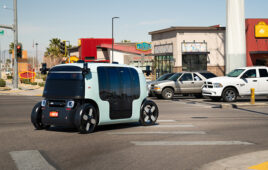|
Listen to this article
|
The safety of autonomous vehicles has been called into question after incidents such as an accident last month involving Cruise led to a pause in operations, layoffs, and the resignation of the company’s CEO. However, development continues, and the Toyota Research Institute recently provided reporters a glimpse into its Accelerated Concepts program in “active safety.”
Toyota Research Institute (TRI) showed how its focus on advanced driver-assist systems (ADAS) rather than directly to fully self-driving cars is intended to prioritize safety. It hosted reporters at Thunderhill Raceway in Willows, Calif., allowing them to ride inside its research vehicles and simulators.
Human drivers are the cause of 94% of accidents, according to a 2018 National Highway Traffic Safety Administration survey. TRI studied verbal and non-verbal feedback as human instructors trained its artificial intelligence.
“Can we save more lives by bringing automated vehicle technology to more people in more places and sooner?” asked Avinash Balachandran, director of TRI’s Human Interactive Driving Division (HID). “We think the answer is yes – by rethinking the way people and embodied technologies interact to create new experiences and value for our customers.”
Toyota Research Institute keeps humans in the loop
Toyota Research Institute said its HID team is researching how to incorporate high levels of autonomy alongside high driver engagement rather than robotaxis. “This approach makes driving both safer and more fun – keeping the driver engaged and working with the car as a truly intelligent partner,” it asserted in a release.
The institute demonstrated systems developed under the HID team’s three “research pillars:”
Human-focused learning: This includes data-driven machine learning techniques to create models of human behavior, said TRI. “From driver awareness to action and intent, these models ensure that the technology will understand drivers and support them in the most natural way possible,” it said.
TRI also provided audio and haptic cues to aid in human-machine interaction.
Driver and vehicle performance and safety: The HID team said it is seeking to build “expert-level driving skills” with artificial intelligence to satisfy these requirements.
At TRI’s event, members of the media witnessed an autonomous self-drifting Toyota Supra test its handling limits. A fully autonomous Lexus LC500 demonstrated its ability to avoid obstacles while charging down the track at high speeds.
“Teaching these expert driving skills to AI helps lay the foundation for autonomous technology to help drivers avoid accidents by navigating sudden obstacles or hazardous road conditions like black ice,” added Toyota.
Shared autonomy: In this component, human drivers and AI would collaborate for a safer and more enjoyable driving experience, explained TRI. Participants had time behind the wheel of TRI’s custom-built Global Research Innovation Platform (GRIP), a research vehicle with four-wheel steering and in-wheel electric motors.
The institute said it uses the vehicle to rapidly iterate driving research. GRIP’s in-car dynamics emulation enables new scenarios for driver training within a controlled environment.
In addition, attendees learned how to countersteer to control drifting through a combination of AI-powered instruction and support before testing their skills on a simulated ice patch.
The journalists also experienced TRI’s AI-powered track-driving coach in a simulator. The coach used real-time natural language to instruct users based on their current actions.
In return, drivers could interact with the agent using a chatbot interface to understand their performance and get tips on how to improve.

TRI’s GRIP test vehicle at Thunderhill Raceway. Source: Toyota Research Institute
TRI shows Driving Sensei to further help drivers
Toyota Research Institute also unveiled its Driving Sensei concept, which uses AI to help drivers gain mastery over the skills of driving through a combination of AI-driven instruction and AI-powered driver support.
Driving Sensei can help people become better, safer drivers while ensuring they are engaged in the driving task, said TRI. The institute was founded in 2015 and has offices in Los Altos, Calif., and Cambridge, Mass.
“Safety is a top priority for Toyota,” stated TRI CEO Gill Pratt. “Our human-centered approach is discovering better, safer ways for humans and AI to collaborate. We’re amplifying people by building models that predict drivers’ actions, developing AI that enhances driver performance.”






Tell Us What You Think!